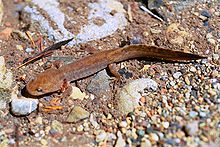California giant salamander: Difference between revisions
m robot Adding: sv:Dicamptodon ensatus |
DeadLinkBOT (talk | contribs) Bot updating dead link(s) - See the pages I've made this fix on; Know a link that need updated? Leave me a message. |
||
| Line 38: | Line 38: | ||
==Range== |
==Range== |
||
The California Giant Salamander is [[endemism|endemic]] to Northern [[California]]. It is found in two (possibly three) isolated regions. The first range includes [[Sonoma County, California | Sonoma]] and [[Marin County, California | Marin]] Counties, southwestern [[Lake County, California |Lake County]], western [[Glenn County, California |Glenn County]], and southern [[Mendocino County]]. The other documented region is south of the San Francisco Bay from central [[San Mateo County]] to southern [[Santa Cruz County, California |Santa Cruz County]] plus western [[Santa Clara County]]. The California Giant Salamander doesn't occur in the East Bay, forming a gap between these two populations.<ref name="caherps" /><ref name="redlist-map">{{cite web |
The California Giant Salamander is [[endemism|endemic]] to Northern [[California]]. It is found in two (possibly three) isolated regions. The first range includes [[Sonoma County, California | Sonoma]] and [[Marin County, California | Marin]] Counties, southwestern [[Lake County, California |Lake County]], western [[Glenn County, California |Glenn County]], and southern [[Mendocino County]]. The other documented region is south of the San Francisco Bay from central [[San Mateo County]] to southern [[Santa Cruz County, California |Santa Cruz County]] plus western [[Santa Clara County]]. The California Giant Salamander doesn't occur in the East Bay, forming a gap between these two populations.<ref name="caherps" /><ref name="redlist-map">{{cite web |
||
| url = |
| url = {{IUCNlink|59080|rangemap=yes}} |
||
| title = |
| title = {{IUCNlink|59080|rangemap=yes}} (image) |
||
| accessdate = 2009-04-14}}</ref> There is an unconfirmed sight record from [[Big Sur]] in [[Monterey County]], approximately 75 miles (100 km) to the south of the documented population in the Santa Cruz area. <ref name="caherps" /> |
| accessdate = 2009-04-14}}</ref> There is an unconfirmed sight record from [[Big Sur]] in [[Monterey County]], approximately 75 miles (100 km) to the south of the documented population in the Santa Cruz area. <ref name="caherps" /> |
||
Revision as of 20:50, 21 November 2009
| California Giant Salamander | |
|---|---|

| |
| Scientific classification | |
| Kingdom: | |
| Phylum: | |
| Class: | |
| Order: | |
| Family: | |
| Genus: | |
| Species: | D. ensatus
|
| Binomial name | |
| Dicamptodon ensatus (Eschscholtz, 1833)
| |
The California Giant Salamander (Dicamptodon ensatus) is a species of salamander in the Dicamptodontidae family. It is endemic to the United States. The species name once additionally included individuals now belonging to the species D. aterrimus (Idaho Giant Salamander) and D. tenebrosus (Coastal Giant Salamander), under the common name Pacific Giant Salamander, which now refers to the genus and family. D. ensatus was split into the three species once it was discovered that they formed genetically distinct populations found in different parts of its range.[2]
Its natural habitats are temperate forests, rivers, freshwater lakes, and freshwater marshes.
Description
The adult California Giant Salamander can reach up 17-30.5 cm (6.7-12 inches) in total length. Like all salamanders, the California Giant Salamander has four toes on the front feet and five toes on the back feet. The California Giant Salamander's tail is around 40 percent of the total length of the salamander and is laterally compressed. The head, back, and sides of the salamander have a marbled or reticulate pattern of dark blotches on a light brown or brassy-colored background. They have a broad head with a shovel-like snout and a fold of skin across the throat called the gular fold. The eyes are medium in size and have a brass-flecked iris and a large black pupil. This species is one of the few salamanders capable of vocalizing.[3]
Range
The California Giant Salamander is endemic to Northern California. It is found in two (possibly three) isolated regions. The first range includes Sonoma and Marin Counties, southwestern Lake County, western Glenn County, and southern Mendocino County. The other documented region is south of the San Francisco Bay from central San Mateo County to southern Santa Cruz County plus western Santa Clara County. The California Giant Salamander doesn't occur in the East Bay, forming a gap between these two populations.[2][4] There is an unconfirmed sight record from Big Sur in Monterey County, approximately 75 miles (100 km) to the south of the documented population in the Santa Cruz area. [2]
Neotenes
Some California Giant Salamander larva continue to grow into an adult and become sexually mature without losing their external gills. This process is called neoteny. Adult-sized neotenes have a uniform brown coloring on their heads, sides, and backs.
References
- ^ Template:IUCN2008
- ^ a b c "Dicamptodon ensatus - California Giant Salamander". Retrieved 2009-04-15.
- ^ C. Michael Hogan (2008). "California Giant Salamander: Dicamptodon ensatus".
{{cite web}}: Unknown parameter|coauthors=ignored (|author=suggested) (help) - ^ "http://maps.iucnredlist.org/map.html?id=59080 (image)". Retrieved 2009-04-14.
{{cite web}}: External link in|title=

